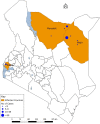Epidemiological Investigation of a Rift Valley Fever Outbreak in Humans and Livestock in Kenya, 2018
- PMID: 32748778
- PMCID: PMC7543801
- DOI: 10.4269/ajtmh.20-0387
Epidemiological Investigation of a Rift Valley Fever Outbreak in Humans and Livestock in Kenya, 2018
Abstract
On the last week of May of 2018, a community-based syndromic surveillance system detected mass abortions and deaths of young livestock in northeastern Kenya. Two weeks later, Rift Valley fever (RVF) was confirmed in humans presenting with febrile illness and hemorrhagic syndrome in the same region. A joint animal and human response team carried out an investigation to characterize the outbreak and identify drivers of disease transmission. Here, we describe the outbreak investigation and findings. A total of 106 human cases were identified in the months of May and June 2018: 92% (98) and 8% (8) of these cases occurring in the northern and western regions of Kenya, respectively. Seventy-six (72%) were probable cases, and 30 (28%) were laboratory confirmed by ELISA and/or PCR. Among the confirmed cases, the median age was 27.5 years (interquartile range = 20), and 60% (18) were males. Overall, the case fatality rate was 7% (n = 8). The majority of the confirmed cases, 19 (63%), reported contact with livestock during slaughter and consumption of meat from sick animals. All confirmed cases had fever, 40% (12) presented with hemorrhagic syndrome, and 23% (7) presented with jaundice. Forty-three livestock herds with at least one suspect and/or confirmed animal case were identified. Death of young animals was reported in 93% (40) and abortions in 84% (36) of livestock herds. The outbreak is indicative of the emergence potential of RVF in traditionally high- and low-risk areas and the risk posed by zoonosis to livestock keepers.
Conflict of interest statement
Disclaimer: The findings and conclusions in this article are those of the authors and do not necessarily represent the official position of the U.S. CDC or any of the other author institutions.
Figures



References
-
- Martin V, Chevalier V, Ceccato P, Anyamba A, De Simone L, Lubroth J, de La Rocque S, Domenech J, 2008. The impact of climate change on the epidemiology and control of Rift Valley fever. Rev Sci Tech 27: 413–426. - PubMed
MeSH terms
LinkOut - more resources
Full Text Sources

